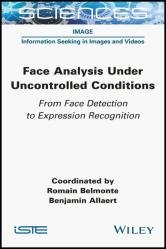Face Analysis Under Uncontrolled Conditions: From Face Detection to Expression Recognition
- Добавил: literator
- Дата: 29-09-2022, 13:14
- Комментариев: 0
 Название: Face Analysis Under Uncontrolled Conditions: From Face Detection to Expression Recognition
Название: Face Analysis Under Uncontrolled Conditions: From Face Detection to Expression RecognitionАвтор: Romain Belmonte, Benjamin Allaert
Издательство: Wiley-ISTE
Год: 2022
Страниц: 312
Язык: английский
Формат: pdf (true), epub
Размер: 38.6 MB
Face analysis is essential for a large number of applications such as human-computer interaction or multimedia (e.g. content indexing and retrieval). Although many approaches are under investigation, performance under uncontrolled conditions is still not satisfactory. The variations that impact facial appearance (e.g. pose, expression, illumination, occlusion, motion blur) make it a difficult problem to solve.
This book describes the progress towards this goal, from a core building block – landmark detection – to the higher level of micro and macro expression recognition. Specifically, the book addresses the modeling of temporal information to coincide with the dynamic nature of the face. It also includes a benchmark of recent solutions along with details about the acquisition of a dataset for such tasks.
Identifying the facial structure is trivial for humans. From the perspective of an algorithm, an image is represented by an array of pixels. From these pixels, the aim is to provide enough abstraction to reach a semantic level that allows facial landmarks to be retrieved. However, it is difficult for an algorithm to have this kind of high level of understanding. To overcome this semantic gap, two solutions have been proposed. The first one, the traditional approach, uses domain-specific knowledge to transform raw data into features (i.e. feature engineering). These features provide useful input for the prediction task, performed by Machine Learning (ML) algorithms. The second one, the Deep Learning (DL) approach, instead of using handcrafted features, lets the algorithm discover the features (i.e. feature learning) needed for the prediction task directly from the raw data. DL involves a series of computational layers, which generally extract low-level features such as edges and curves, up to more abstract concepts. Such models are called Deep Neural Networks (DNNs). Thanks to the increase in computational power and available data, DNNs have shown over the past few years impressive capabilities. They have completely disrupted the field of computer vision. In most tasks, the community has shifted from feature engineering to DNNs architecture engineering.
Скачать Face Analysis under Uncontrolled Conditions
Внимание
Уважаемый посетитель, Вы зашли на сайт как незарегистрированный пользователь.
Мы рекомендуем Вам зарегистрироваться либо войти на сайт под своим именем.
Уважаемый посетитель, Вы зашли на сайт как незарегистрированный пользователь.
Мы рекомендуем Вам зарегистрироваться либо войти на сайт под своим именем.
Информация
Посетители, находящиеся в группе Гости, не могут оставлять комментарии к данной публикации.
Посетители, находящиеся в группе Гости, не могут оставлять комментарии к данной публикации.
